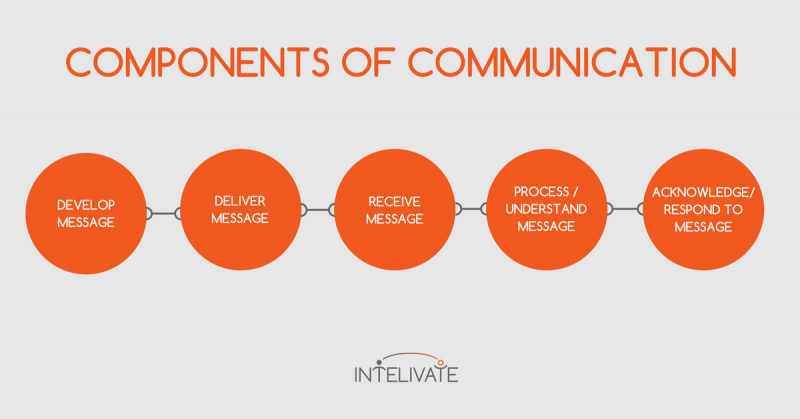The communication process might seem simple, but so much can go wrong with it at any point. You’ll learn how to identify and prevent the nine biggest communication barriers.
If you’ve ever played the telephone game, you know how much in the communication process can go wrong. You laugh at the mangled message at the end of the game.
However, when you mangle messages in your career and relationships, the result is not as funny. I have a million trophies of mangled messages when the communication process goes sour.
I’ll walk you through nine of the biggest communication barriers and tell you how to knock them out.
First, let’s start with all the components that can complicate the seemingly simple process of communications.
Components of the Communication Process
A communication is one discreet interaction.
A conversation consists of multiple communications. The sender and receiver swap roles multiple times throughout the dynamic communications process.
Each of us is involved in hundreds, even thousands, of communications each and every day.

The communication process seems simple right?
There are so many things that can and do go wrong during these simple five components of communication. This is especially true when you are delivering bad news or working to resolve a conflict.
At any point in this process, obstacles or communication barriers can ‘break the communication chain’ resulting in the need for both the sender and receiver to begin the process again or, worse, the complete breakdown of the communication process occurs.
Whether you are preparing for an interview, leadership coaching session or just looking to build persuasive communication techniques, stay aware of these nine most common barriers in communication.
9. Mental Roadblocks and Distractions
Have you ever driven home from work after a long day and pulled into your driveway and not remembered ONE part of your drive home?
It happens all the time and this is a perfect example of being distracted or encountering a mental roadblock.
You’re done and have mentally checked-out. You’re human.
This is one of the biggest communication barriers. It keeps you from actively listening and hearing vital information during the communication process.
Here are some tips to avoiding mental roadblocks in the communication process:
- Be fully present. Avoid important conversations while multitasking. Actually, don’t have ANY conversations while multitasking. It’s rude and little or anything is accomplished.
- Put the phone away. Yes – turn it off or over to avoid notification distraction. If the conversation is important, it’s worth it to avoid immediately running into this communication barrier.
- Are you mentally tired? Try to avoid the conversation and establish a time when you know you’re prepared.
8. Past/Common Experiences or Perceptions
As individuals, we all have perceptions which define us as individuals. For example, how many of you are fearful of flying or get nervous during turbulence? It is likely because you have either experienced something first-hand or perceive a certain level of danger based on second-hand accounts or reports. How many of you have virtually no fear of flying and find it exciting?
This is an example of different experiences and perceptions. Because these experiences/perceptions are different between these two groups, this could be one of the multiple barriers in communication when discussing travel or flying. You simply don’t relate with one another on the topic.
What you can do to avoid perception communication barriers:
- Come to the conversation with an open mind. Be prepared to learn especially when resolving tensions.
- During negotiations, listen more than you talk to learn about experiences you connect with and perceptions you might need to overcome.
- Leave your baggage at the door. If you don’t have the first-hand experience, avoid using hearsay to finalize your perceptions. Experiences over perceptions give you credibility. I cannot tell you the number of times I’ve had to overcome these communication barriers to achieve a working relationship. It’s worth it.
7. Power-Distance Culture
The power-distance culture is one of the most destructive communication barriers.
For example, if you are pulled over by a police officer, are you likely going to say exactly what is on your mind and in a manner that you would with your best friend? You likely would not, because of a “power distance” between the officer and yourself. This goes both ways, as the officer will likely expect that you will demonstrate a level of respect in communication because of this same “power distance”.
The problem occurs – especially with bad leaders and organizations – when this communication barrier keeps vital information from getting to you.
Avoid power-distance culture communication barriers:
- Regardless of your position, instill a culture of frank but respectful feedback.
- Reward those who give you difficult but vital information. They were brave to come forward and you need that information to keep coming to you.
- Be fully prepared and willing to hear what you need to hear and not what you want to hear.

6. Word Selection
Ahhhh – the old saying,
It’s not what you say, but how you say it.
Your word selection can be one of the biggest communication barriers and ties into the past and common/perceptions as well as power distance/culture.
For example, you may often and freely use profanity or ‘slang’ with close friends, but this could cause a communication barrier if you chose these same words in speaking with your boss, or an officer or with someone who doesn’t appreciate the word choice or understand it. This can be especially true with slang and generational gaps.
The same goes for industry jargon. Walk out of your world for a moment and determine what others might not understand. Industry terms can immediately block the communication process. Why? People normally don’t want to immediately declare,
“I don’t understand what you’re talking about.”
Avoid ‘word selection’ communication barriers by:
- Know your audience. Like on social media, different audiences do not receive messages in the same way.
- Do your research. If you aren’t familiar with the person, find out how they communicate. How? Watch social media, interactions with others or simply ask those who have direct experience.
- If you aren’t getting the results you want, adjust your approach and word selection. This quickly mitigates any communication barriers that occur early in the communication process.
5. Prematurely Judging the Speaker
We are human and we’ve gotten this far by being aware of our surroundings and using past experiences. However, going to far and not having an open mind can be one of the most devastating communication barriers.
As humans, we immediately judge or make preconceived notions when we encounter something new or unfamiliar, including people. For example, when you first encounter a new person, you immediately developed impressions of one another based on appearance and body language. This happens immediately, often unconsciously and likely before either of you have spoken.
Avoid ‘judging’ communication barriers by:
- Don’t allow your first impression to be the only impression. Keep an open mind as the dialogue starts.
- Do everything possible to make a fantastic first impression yourself. Even if there is familiarity, come into the dialogue calm, cool and collected.
- Think you are judged prematurely? Try and determine what it is and work to put the other person at ease. Many times this comes down to the power-distance culture I mentioned above.
4. Emotions or Lack of Motivation
“I’m really upset and I think you should be too!”
Being overly or showing a lack of emotion is one of the barriers that occur at either end of the communication process.
Think of an argument that you have been in with a person. If you are highly emotional and that person is speaking, are you truly listening to what they are saying?
Not likely, as you are focused on getting YOUR point across!
You may let the person speak, but that doesn’t mean that you truly comprehend what is being communicated.
The same can be said of a lack of motivation. If you don’t feel motivated in the situation or communication, message comprehension is greatly diminished.
Here’s how to avoid emotional communication barriers:
- Match emotions and enthusiasm to the other person when appropriate. Be genuine. People can see through the fake.
- Is the other person being overly emotional? Be the leader (but don’t use any of our funny leadership quotes in the process) and set the example by staying cool and calm. Just don’t get so calm that you appear condescending.
- Not feeling the level of energy that you should or feeling too emotional? Take a break and reconvene if possible.
3. Lack of Empathy
Displaying lack of empathy is a HUGE communication barrier and often comes from a lack of understanding or connection to what’s being communicated.
Lack of empathy links back to past/common experiences as well.
If you tell me about an experience that is really important to you and my response is:
“That’s great, but I really need you to focus on this exercise”
What happens to you mentally?
You become “stuck” on the lack of empathy which can present both a mental roadblock and an increase in negative transition words and emotion. This demonstrates how one barrier – if not managed correctly – can spiral and cause multiple communication barriers.
How to avoid empathy communication barriers:
- Provide empathy when appropriate and take your ego out of it. Empathy just means you ‘get it.’ It does not mean that you forgive the person or action in that moment. For your benefit, though, it’s important to eventually forgive but never forget.
- Empathy is required to move the person forward emotionally in the communication process. If the conversation is ‘stuck’ then providing a quick empathy statement does wonders to move the topic forward.
- Under NO circumstances NEGATE empathy – especially when attempting to deliver criticism effectively. The statement above is a great example of negating empathy. You provide the empathy statement and then qualify it with a ‘but,’ ‘however,’ ‘unfortunately’ or some other word that diminishes the impact of an empathy statement.
2. Incomplete Message / Interruption
Being interrupted doesn’t only present a major communication barrier, it also sets emotional fires during conversations. Getting an incomplete message or interrupting causes two major communication breakdowns.
First, you don’t truly hear the complete message. In other words, you are likely perceiving (another potential roadblock) what the other person is saying and don’t allow the message to be completed. This perception can often be incorrect.
Second, an interruption makes the other person emotional, especially if it is perceived as rude or inconsiderate. This presents a mental roadblock from the other end and is another example of one barrier building up to multiple communication barriers!
How to avoid ‘incomplete message’ communication barriers:
- Don’t interrupt. It can be hard especially in emotional conversations. If someone is continuously interrupting you, calmly point it out and then move on to the conversation.
- If you find the need to interrupt, use a signaler at an appropriate time (‘May I,’ ‘I’d like to say’) and start or end with an empathy statement.
- Listen to the message and not the words. Easier said than done, but the message is always the most important output of the communication process.
1. Body Language
If how you say something is more important than what you say, then body language is critical, especially in conflict management strategies.
On conference calls? Body language is just as crucial. It is a HUGE component of communication over the phone.
If you are slouched in your chair or leaning back “relaxing,” what naturally happens to your tone and speech? It reflects your body language! Therefore, it is still very important to be conscious of body language even with communication via the phone.
Avoid body language communication barriers:
Here are types of body language to avoid in order to keep the communication process healthy:
- Crossing arms
- Tapping feet
- Drumming fingers
- Fidgeting with a watch, jewelry, tie
- Slumping in your chair or not standing upright
- Yawning
- Biting of lips (signals anxiety)
- Raising eyebrows (can indicate disbelief)
- Wringing of hands
- Holding your head up with your hand
- Closed-handed gestures
- Repeatedly shrugging of shoulders
- Nervously shifting of weight
- Cringing
The power of body language is incredible. It’s one of the great leadership approaches I learned from watching my rescue dogs.
Final Thoughts and Reminders
Communication is dynamic. Just because you are managing communication barriers from your end of the communication does not mean the other person(s) is identifying/managing them from their end. Therefore, you must be aware that these barriers can impact either end of the communication.
Be the leader and constantly monitor, identify and manage potential barriers in communication from BOTH ends of the process.
If you have any questions or any stories of where you got caught up in some of these common communication barriers, I would love to hear from you over on Twitter or Facebook!
Don’t forget to subscribe to get out best business and career insights delivered directly to you! Just hit the green button above – and we promise to keep your information just with us and we’ll never spam.
Keep Reading: 11 Conflict Management Strategies to Quickly End an Argument →
Related Solutions to Help With Your Career, Leadership & Team Communications.
Kris Fannin
Kris Fannin is a passionate change agent in workforce transformation. For more than 25 years, he's had the privilege of partnering with dozens of client organizations and leading hundreds of teams to become powerful influencers.
"Your legacy will be defined by the passion and impact of the people you influence. What do you want your legacy to be?"



